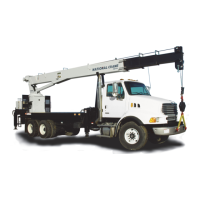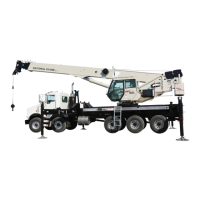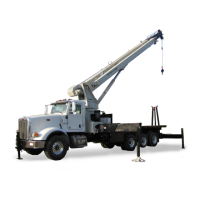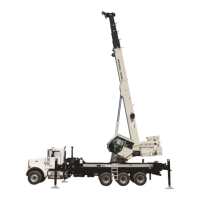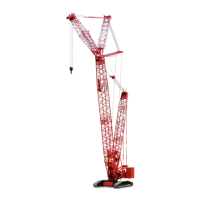National Crane PUBLISHED 04-26-2019 CONTROL # 113-09 3-17
600E2 OPERATOR MANUAL OPERATING CONTROLS AND PROCEDURES
turned on, the receiver will not be initialized. Once the
receiver has been initialized, the unit will be allowed to
operate. Should an emergency situation occur, the receiver
may be “shut down” by pressing the Emergency Stop Switch
on the transmitter. This must be pressed while transmitter
power is in the ON position. This special code will be
transmitted for a period of 10 seconds.
When the receiver receives this special code, the power to
the output driver circuit will be de-activated. To resume
operation, the transmitter must again send the special code
to re-activate the receiver. To achieve this, turn transmitter
power off and back on.
The transmitter will again go through its routine to initialize
the receiver. Please instruct your operators how to use
this “Emergency Stop” and insist that they operate this
feature to become familiar with the characteristics
involved.
Frequently Asked Questions
Question Answer
What kind of range can be expected? Advertised at 400 feet. Very likely to be much greater. The environ-
ment, terrain, antenna placement, and transmitter’s position can play
an important role in achieving maximum range.
What method of transmission is being utilized? The radio uses Radio Frequency (RF) at 49 Megahertz (49 MHz).
Why 49 MHz? The Federal Communications Commission (FCC) dictates the fre-
quency spectrum for the purpose of radio control devices. There are
several bands that can be used. A lower band was chosen to reduce
the “line-of-sight” characteristic. Lower frequencies tend to follow the
curvature of the Earth, which will allow control in areas that are not
“line-of-sight” such as ravines, embankments, cliffs, and even build-
ings.
Do you use amplitude modulation (AM) or fre-
quency modulation (FM)?
FM is utilized. FM is a must in electrically noisy environments. These
environments include areas with welders, power lines, industrial
machinery, etc. A good analogy is a standard automobile radio. In the
above mentioned areas, the radio will have static on AM stations. Your
FM stations assure definite clarity and a common extended range.
Will our current 2-way radio affect the operation
of the wireless controller?
No. Two-way radios are assigned to different bands in the frequency
spectrum and at high frequencies. At the lower frequencies such as 49
MHz, the power density in a given area is much lower than at higher
frequencies therefore much less chance of interference.
Is the unit affected by outside interference? Any receiver will receive frequency to which it is tuned. Should the
radio remote unit receive an interfering signal which is at the same fre-
quency, the “Smart Logic” analyzes the incoming signal to determine
validity. First, it must be a digitally modulated FM carrier, it must have
the exact data stream length and appropriate baud rate. The data
stream length totals 120 bits of information. The baud rate is the speed
at which these bits are transmitted. The first 120 bits are stored and
compared to the next consecutive 120 bit data stream(s). Each of
these 120 bit data streams are broken down into groups of bits called
data words or bytes. These bytes reflect each individual switch and/or
position along with additional information of the transmitter. Also
included is an address code that must match the codes of the appropri-
ate transmitter. If any bits of this data stream are wrong or missing the
outputs will not be updated. Should there be a possible interfering sig-
nal present, normally the wireless transmitter is operated at a closer
range than the interfering signal and the receiver will perform properly
since it will pick up the strongest signal.
Fo
r
Reference
Only

